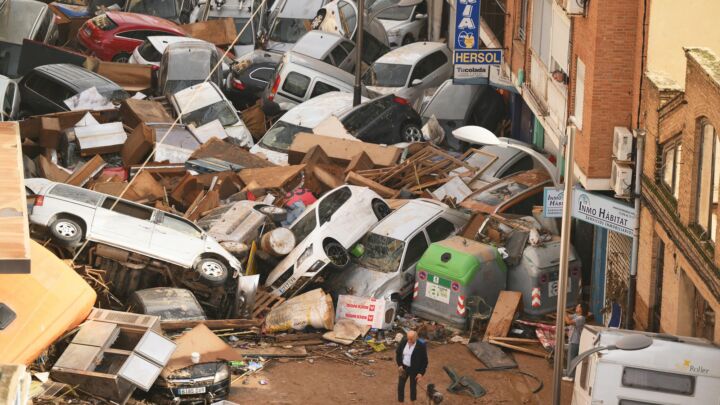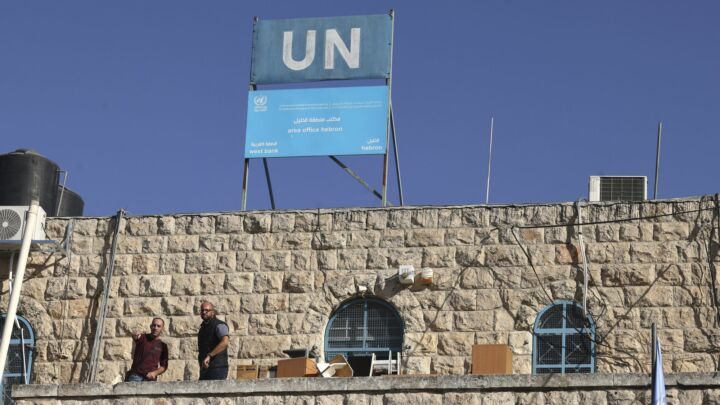Searching for a mission, not just missiles
Why US forces are more desperate than ever to find Iraq's alleged weapons of mass destruction.

Want to read spiked ad-free? Become a spiked supporter.
It isn’t only Iraqi civilians who are looting and rooting around Ba’ath Party buildings and Saddam’s smashed-up palaces for anything useful – so too are American forces, in their desperate search for Iraq’s elusive weapons of mass destruction.
The war may be pretty much over, and UK prime minister Tony Blair may have uttered the word ‘victory’ (though he promised that coalition forces would not indulge in ‘any spirit of elation, still less of triumphalism’) (1). But according to Bush officials, the search for Saddam’s deadly weapons remains a number one priority. As US secretary of state Colin Powell says: ‘The combat period is over, and we can now turn our attention to finding weapons of mass destruction.’ (2) In short, having won the war, coalition forces now need to justify it.
It’s not hard to work out why US officials are keener than ever to find buckets of white powder or canisters of noxious gases. From the outset, they described the war as an attempt to ‘disarm Saddam’ of his alleged weapons of mass destruction. On 22 January, two months before the war started, President Bush said Saddam was ‘a dangerous, dangerous man with dangerous, dangerous weapons’ (3). ‘He’s a danger to America and to our friends and allies and that’s why the world has said, “Disarm”’, said Bush (4).
But there seems to be more to America’s desperate hunt for weapons than a desire simply to justify the current campaign. US forces appear to be searching, not just for dodgy gas, goggles and guns, but for some vindication of their entire international mission. Having defined their post-9/11 world role as standing up to terrorists and failing states, Bush and co are keen to make real their claims about the ‘embittered few’ threatening America with ‘catastrophic technologies’ (5). In the deserted outposts of Iraq’s deserts, America is searching for a sense of meaning and mission on the world stage.
It would be surprising if US forces did not find some traces of white powder or evidence of noxious gas somewhere in Iraq. But the desperate search for such traces reveals something of America’s defensiveness in its current campaign.
America’s all-out focus on finding weapons has led to many false starts and false alarms in the past three weeks:
- On 4 April, CNN sent out a Breaking News email alert reporting that ‘US officer says American troops find thousands of boxes of unknown white powder…south of Baghdad’. The following day a Reuters report said that ‘first tests of the white powder…indicate that it was not a chemical weapon’. ‘[I]t does not appear to be a chemical that could be used in a chemical weapons attack’, admitted US Colonel John Peabody (6).
- On 7 April, a headline in the Washington Post claimed that ‘US says it may have found Iraqi WMD storage site’, as Major Ross Coffman suggested that US forces had found a ‘sarin site’. Later the same day, Gulf News reported that ‘the facility near Baghdad that a US officer said might be “smoking gun” evidence of Iraqi chemical weapons production turned out to contain pesticide, not sarin gas’ (7).
When they aren’t leaking every potential weapons find to the waiting media, US forces have issued statements about ‘other things’ (as one general put it) that could, potentially, point to the existence of banned weapons. On 14 April, US Brigadier Ben Freakley announced that his forces had found ‘about 1000lb’ (cue gasps from the media) of…documentation, possibly relating to WMD (14). Since when was the war about uncovering Iraq’s documents of mass destruction? US forces have also paraded gas masks and chemical suits found inside Iraq as evidence that Saddam’s regime must have had banned weapons.
Iraq’s banned weapons always seem to be somewhere else. At the start of the war, US officials claimed that 10 sites in western Iraq housed weapons of mass destruction – until a US military official told the Washington Post that ‘[a]ll the searches have turned up negative. The munitions that have been found have all been conventional’ (15). Defence secretary Donald Rumsfeld responded by telling ABC News that, in fact, the weapons are further inside Iraq, ‘in the area around Tikrit and Baghdad’. When searches in Baghdad proved so-far fruitless, some headlines claimed that ‘Iraqi WMD possibly in Syria’ (16). Any advances on Syria?
Some US officials argue that there are just too many damn sites to search, and locating the banned weapons could take months, ‘if not years’. The New York Times reports that US forces are focusing on ‘about 36 sites…but the inspection of the sites is expected to take at least a month’ (17). These 36 sites were apparently whittled down from ‘more than 1000 laboratories, plants, military installations and storage facilities [that may] contain banned weapons’ (18). US General Tommy Franks claims that ‘up to 3000 potential weapons of mass destruction sites are being investigated across Iraq’ (19). Any advances on 3000?
Things got so bad that Donald Rumsfeld felt the need to clamp down on reports about alleged weapons finds. On 9 April, Rumsfeld cautioned the media: ‘We have to recognise that almost all first reports that we get turn out to be wrong. It takes days to get samples of things from wherever they are in the battlefield into a place where they can take a look’ (20). Yet it was statements from Rumsfeld’s defence department in the run-up to the war, and from his men on the ground during the war, and from Pentagon officials now that the war has ended, that made WMD such a big issue.
During the war, when the banned weapons failed to turn up, the focus of the coalition’s PR campaign subtly shifted away from ‘disarming Saddam’ towards the ‘barbarity of Saddam’s regime’. Before the war, President Bush said the ‘central objective’ would be to ‘disarm Saddam’; on the second day of the war, Rumsfeld listed America’s eight objectives in the war, the first being to get rid of Saddam and the second being to destroy his WMD; by day 10, when Pentagon spokesman Victoria Clarke restated US objectives, finding the alleged weapons had fallen to number four, and destroying them to number five (21).
According to some reports, this deprioritisation of WMD had the desired effect. On 5 April, a few days after Victoria Clarke did her American objectives countdown, the Washington Post reported that ‘a growing majority of Americans believe the war in Iraq is justified even if the United States does not find weapons of mass destruction’ (22). A Washington Post/ABC News poll discovered that 69 percent of those surveyed thought that going to war with Iraq was ‘the right thing’, with or without the discovery of biological or chemical weapons (23).
Yet now, after flagging up Saddam’s barbarity, flagging down the alleged weapons, and winning the war, US officials continue to talk up WMD, which they are ‘certain’ exist somewhere in Iraq. Colin Powell says the main aim now is to find those weapons, while White House spokesman Ari Fleischer says: ‘We have high confidence that they have weapons of mass destruction. This is what this war was about and is about.’ (24) Why, even as the war comes to an end and US forces get some temporary payback for having defeated Saddam’s regime, do US officials keep banging on about WMD?
The focus on finding weapons – some real, tangible result of the campaign in Iraq – shows up America’s sense of defensiveness about its war in the Gulf. Bush officials see their international authority over Iraq as being bound up with finding the alleged weapons. US leaders are defensive about having taken what many consider to be effectively unilateral action over Iraq, without the backing of the UN, and are determined to prove their apparently benign and selfless case for war, even if retrospectively.
In their clashes with the UN and their spats with chief weapons inspector Hans Blix before the war, US spokesmen constantly emphasised the threat posed by Saddam to the world. In January 2003, the White House published a statement entitled ‘Disarm Saddam Hussein’, which claimed that ‘[t]he gravest danger we face…is outlaw regimes that seek and possess nuclear, chemical and biological weapons’ (25). Uncertain of their international standing, US officials are now pulling out all the stops to show Blix and co that they were right all along, that their war was justified, and that America really isn’t a gung-ho tyrant.
As well as justifying the war to their critics, US officials’ desperate scrabbling around for Iraq’s banned weapons looks like an attempt to make real their claims about our dangerous world, and America’s role within it. America’s post-9/11 mission has been defined by the alleged threats from ‘over there’ – from the ‘axis of evil’ states and their desire for nuclear bombs that Bush spoke of in his 2002 State of the Union address; to the ‘embittered few’ who hate America, as described in the September 2002 National Security Strategy; to ‘evil Saddam Hussein’ and his ‘dangerous weapons’ that Bush pointed to in his 2003 State of the Union address.
On 19 March, the day the war against Iraq started, Bush said America ‘would not live at the mercy of an outlaw regime that threatens the peace with weapons of mass murder’ (26). From US-hating terrorists to outlaw regimes that are apparently holding America to ransom, America’s post-9/11 foreign policy has been defensive, rather than assertive. America has defined its world mission in reaction to alleged events in the unpredictable and unknowable territory of the third world, rather than asserting a clearly defined global authority. It is this focus on ‘over there’ that can make something like Iraq’s alleged weapons such a crucial find for US forces.
America’s war in Iraq was a focal point for asserting Washington’s sense of mission – a mission against evildoers, unknowable terrorists, ruthless regimes, and other assorted ‘dangerous, dangerous men, with dangerous, dangerous weapons’. Now, US officials hope that they can locate something, anything, in Iraq – some weapon that is outlawed or dangerous or dodgy – thereby solidifying their claims to action in our dangerous world. Unable to assert a positive American role in the world, US officials hope that the discovery of bad things in Iraq will be enough to justify America and its mission – whatever that might be. As one US official claimed, the weapons would ‘show…why we went there’, and why America needs to ‘keep pursuing these dictators’ (27).
American forces may soon find some kind of banned weapons. But they won’t find what they’re really looking for in the bombed-out buildings of Iraq.
Brendan O’Neill is coordinating the spiked-conference Panic attack: Interrogating our obsession with risk, on Friday 9 May 2003, at the Royal Institution in London.
Read on:
spiked-issue: War on Iraq
(1) ‘Blair uses the v-word’, David Wooding, The Sun, 15 April 2003
(2) Combat phase is over, says Powell as final push begins, Terry Kirby, Independent, 14 April 2003
(3) Bush repeats warning on dangers posed by Saddam Hussein, Wendy S Ross, US Department of State, 22 January 2003
(4) Bush repeats warning on dangers posed by Saddam Hussein, Wendy S Ross, US Department of State, 22 January 2003
(5) National Security Strategy of the United States of America, White House, September 2002
(6) Tests indicate Iraq powder not chemical weapon, Luke Baker, Reuters, 5 April 2003
(7) Fierce fighting in Baghdad, Gulf News, 8 April 2003
(8) Weapons-grade plutonium possibly found at Iraqi nuke complex, Fox News, 11 April 2003
(9) Experts say troops broke UN seals, Associated Press, 11 April 2003
(10) US forces test canisters for chemical weapons, ABC News, 14 April 2003
(11) US forces test canisters for chemical weapons, ABC News, 14 April 2003
(12) Buried vans could be chemical weapons labs, say US troops, Oliver Burkeman, Guardian, 15 April 2003
(13) Buried vans could be chemical weapons labs, say US troops, Oliver Burkeman, Guardian, 15 April 2003
(14) Buried vans could be chemical weapons labs, say US troops, Oliver Burkeman, Guardian, 15 April 2003
(15) Fruitless searches could lead to UN clash, Barton Gellman, The Age, 31 March 2003
(16) Iraqi WMD possibly in Syria, News 24, 31 March 2003
(17) US search for illegal arms narrowed to about 36 sites, Don Van Natta Jr and David Johnston, New York Times, 12 April 2003
(18) US search for illegal arms narrowed to about 36 sites, Don Van Natta Jr and David Johnston, New York Times, 12 April 2003
(19) Up to 3000 mass destruction weapons’ sites under investigation: Franks, Pakistan Tribune, 15 April 2003
(20) Rumsfeld urges caution on chemical suspicions, Marian Wilkinson, Sydney Morning Herald, 9 April 2003
(21) See It’s a propaganda war, but not as we know it, by Mick Hume
(22) More say war justified without finding weapons, Richard Morin and Claudia Deane, Washington Post, 5 April 2003
(23) More say war justified without finding weapons, Richard Morin and Claudia Deane, Washington Post, 5 April 2003
(24) US search for illegal arms narrowed to about 36 sites, Don Van Natta Jr and David Johnston, New York Times, 12 April 2003
(25) Disarm Saddam Hussein, White House, January 2003
(26) See A hollow war, by Brendan O’Neill
(27) Up to 3000 mass destruction weapons’ sites under investigation: Franks, Pakistan Tribune, 15 April 2003
Celebrate 25 years of spiked!
A media ecosystem dominated by a handful of billionaire owners, bad actors spreading disinformation online and the rich and powerful trying to stop us publishing stories. But we have you on our side. help to fund our journalism and those who choose All-access digital enjoy exclusive extras:
- Unlimited articles in our app and ad-free reading on all devices
- Exclusive newsletter and far fewer asks for support
- Full access to the Guardian Feast app
If you can, please support us on a monthly basis and make a big impact in support of open, independent journalism. Thank you.








Comments
Want to join the conversation?
Only spiked supporters and patrons, who donate regularly to us, can comment on our articles.